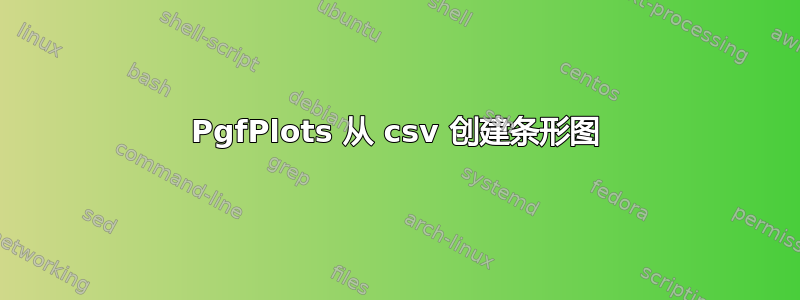
你好,我正在写论文,需要包含一些我编写的软件的性能数据。
我使用不同数量的数据测量了多次执行中多个操作的性能。
它看起来像这样:
COUNT,CREATE,MODIFY,SAVE,LOAD,QUERY,QMOD,DETACH,SAVE2
100,64.27,5.63,19.05,13.71,0.38,0.66,3.11,9.50
1000,64.57,20.03,44.80,35.52,1.32,2.93,12.49,18.84
10000,117.21,149.09,375.53,298.99,13.21,32.99,142.09,154.24
100000,582.70,1565.79,5405.86,3055.01,163.56,395.25,1651.06,1416.73
1000000,5599.48,16677.71,71239.38,32612.74,1948.06,4452.54,17148.97,12677.84
第一列表示输入数据的大小,其余表示执行时间。
我需要创建分组条形图,其中 COUNT 中的每个值都有组,并且每个组包含条形CREATE,SAVE,MODIFY ...。
这样的事情可能吗?我已经尝试这样做了几个小时,但毫无进展。
这看起来像是我需要的东西:
我成功使用 pgfplotstable 导入了数据,但无法从中创建实际图表。
答案1
所以我猜您正在寻找以下内容,对吗?
有关其工作原理的详细信息,请查看代码中的注释。
% used PGFPlots v1.14
\begin{filecontents}{data.csv}
COUNT,CREATE,MODIFY,SAVE,LOAD,QUERY,QMOD,DETACH,SAVE2
100,64.27,5.63,19.05,13.71,0.38,0.66,3.11,9.50
1000,64.57,20.03,44.80,35.52,1.32,2.93,12.49,18.84
10000,117.21,149.09,375.53,298.99,13.21,32.99,142.09,154.24
100000,582.70,1565.79,5405.86,3055.01,163.56,395.25,1651.06,1416.73
1000000,5599.48,16677.71,71239.38,32612.74,1948.06,4452.54,17148.97,12677.84
\end{filecontents}
\documentclass[border=5pt]{standalone}
\usepackage{pgfplots}
\usepackage{pgfplotstable}
\pgfplotsset{
% use this `compat' level or higher to position the bars in one group
% next to each other
compat=1.7,
}
% load the data table ...
\pgfplotstableread[col sep=comma]{data.csv}{\loadedtable}
% and store the number of columns in `\NoOfCols'
% (minus 1 because counting in `\foreach' starts with zero
\pgfplotstablegetcolsof{\loadedtable}
\pgfmathtruncatemacro{\NoOfCols}{\pgfplotsretval-1}
\begin{document}
\begin{tikzpicture}
\begin{semilogyaxis}[
% adjust the `width' a bit by keeping the default `height'
width=1.2*\axisdefaultwidth,
height=\axisdefaultheight,
% set appropriate `ymax' value so the `nodes near coords' fit to the plot
% (adjusting the `ymin' value is just to make it look a little bit better)
ymin=1e-1,
ymax=1e6,
% there should be no gap between the bars in one group
ybar=0pt,
% use data from the table for the xticklabels
xtick=data,
xticklabels from table={\loadedtable}{COUNT},
% to start the bars from the bottom edge of the plot
% (otherwise they would start from 10^0
% borrowed from <http://tex.stackexchange.com/a/86688/95441)
log origin=infty,
% adjust the size of the bars so they don't overlap
% (you can play with the numerator to change the gap between the groups)
bar width=0.85/\NoOfCols,
% enlarge the x limits so all of the bars are shown
% (play with the value to adjust the gap on the sides of the plot)
enlarge x limits={abs=0.6},
% and position the legend outside of the plot to not overlap with the data
legend pos=outer north east,
% add `nodes near coords'
nodes near coords={
% because internally PGFPlots works with floating point numbers, we
% change them to fixed point numbers
\pgfkeys{
/pgf/fpu=true,
/pgf/fpu/output format=fixed,
}%
% check if numbers are greater than 1000 and if so, divide them by
% 1000 to convert them from ms to s scale
\pgfmathparse{
ifthenelse(
\pgfplotspointmeta < 1000,
\pgfplotspointmeta,
\pgfplotspointmeta/1000
)
}%
% to now decide which of the two cases we have, we compare the
% point meta value, but because `\ifnum' compares integers, we first
% have to convert the fixed number to an integer
\pgfmathtruncatemacro{\Y}{\pgfplotspointmeta}%
\ifnum\Y<1000
\pgfmathprintnumber{\pgfmathresult}\,ms
\else
\pgfmathprintnumber{\pgfmathresult}\,s
\fi
},
% set the style of the `nodes near coords'
nodes near coords style={
font=\tiny,
rotate=90,
anchor=west,
},
% as basis for the `nodes near coords' use the raw y values
point meta=rawy,
]
% add the data rows
\foreach \i in {1,...,\NoOfCols} {
\addplot table [
x expr=\coordindex,
y index=\i,
col sep=comma,
] {\loadedtable};
% to automatically add the legend entries first extract the
% column name and store it in `\colname'
% (this is an undocumented command so far. I borrowed it from
% <http://tex.stackexchange.com/q/171021/95441>)
\pgfplotstablegetcolumnnamebyindex{\i}\of{\loadedtable}\to{\colname}
% now you can add the legend entry
% (because we are in a loop we have to use the "expanded" version)
\addlegendentryexpanded{\colname};
}
\end{semilogyaxis}
\end{tikzpicture}
\end{document}




